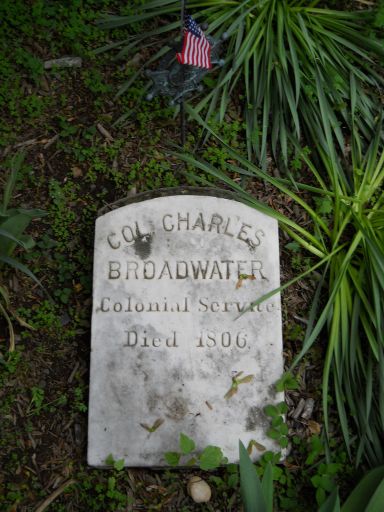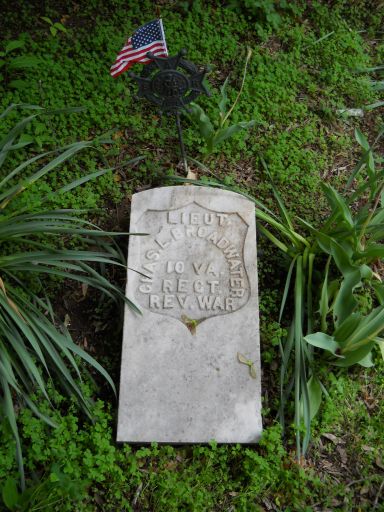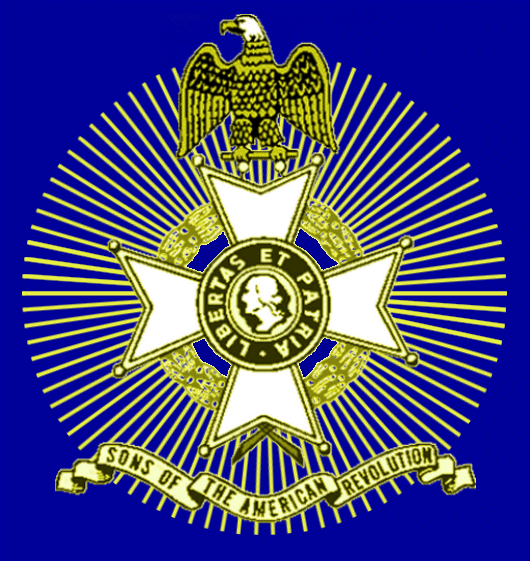The Revolutionary Services of
Col. Charles Broadwater and Lt. Charles Lewis Broadwater
By John D. Sinks, Fairfax Resolves Chapter, Sons of the American Revolution
05 November 1989
Col. Charles Broadwater was born in 1719. He assumed many of the responsibilities expected of the gentry in the mid-18th century: gentlemen justice, vestryman, and militia officer. During the French and Indian War he saw active duty as a captain, and was promoted to the rank of major. His real leadership, however, came during the Revolution.
Relations between the colonies and Great Britain deteriorated during the summer of 1774. Gov. Dunmore dissolved the House of Burgesses in May. When a circular letter arrived from Boston proposing a suspension of trade with Great Britain, twenty-five Burgesses were still in the vicinity of Williamsburg. They called for a state convention. On 14 July Fairfax County selected its delegates: George Washington and Charles Broadwater. Washington had some doubts about his colleague. He wrote to Bryan Fairfax, “...Major Broadwater, though a good man, might do as well in the discharge of his domestic concerns, as in the capacity as a legislator.” Fortunately, Washington’s doubts proved to be unfounded.
Four days after the election, the freeholders of Fairfax County met and passed the Fairfax Resolves. The document defended the rights of the colonists, condemned the British government, and called for certain actions. The twenty-fourth article directed the delegates, Washington and Broadwater, to present the Resolves to the Virginia Convention. The twenty-fifth article named twenty-five men to a committee with emergency powers of government, later called The Committee for Safety. Charles Broadwater was one of the men.
Charles Broadwater attended not just the First Virginia Convention, but the Second, Third, and Fourth as well. The First Convention met on 1 August 1774. It passed an article of association to limit trade with Great Britain. Both Washington and Broadwater signed the Association. The Convention also recommended that counties establish independent militia companies, i.e., independent of the royal governor. The Fairfax Committee, of which Broadwater was a member, did so and levied a poll tax of three shillings for ammunition and expenses. This was the first Virginia Committee for Safety to levy a tax. The Second Virginia Convention of March 1775 selected representatives to the Continental Congress and resolved that the colony be placed in a state of defence. The Third Virginia Convention of July and August, 1775 was the first to meet after the outbreak of war. This Convention undertook the replacement of the royal government in earnest. It selected officers for the 1st and 2nd Virginia Regiments, authorized battalions of minutemen, took financial responsibility to the Point Pleasant Campaign of 1774, and established the Virginia State Navy. The Fourth Virginia Convention of December 1775 and January 1776 partly restored the court system and authorized seven new Continental Regiments.
The absence of the Fairfax County Court Order Book for 1774-1783 leaves many questions about Charles Broadwater’s service during the Revolution. He did run a recruiting station at The Falls Church in 1776.
This brings us up to the time when Charles Lewis Broadwater, the son, began his military service. The new Virginia State Navy began defence programs for each of the major waterways in the state. George Mason and John Dalton formed a committee of two to purchase and build the Potomac Fleet. The largest of the fourteen ships was the American Congress, a ship of 110 tons, armed with fourteen four and eight pounders, and carried a crew of 96, including a company of marines. Broadwater was commissioned as a midshipman on 8 March 1776 and assigned the American Congress. He was about 24 years old.
The Congress remained in the Potomac until the superior fleet of Gov. Dunmore sailed from the Chesapeake at the beginning of August. By 1 September 1776 the Congress was in Norfolk. With the Manley, the Congress convoyed the Adventurer to Cape Hatteras. On the return trip, the Congress was chased by the superior H.M.S. Fowey, but escaped.
Charles Lewis Broadwater left the Navy in November of 1776, according to some documents in his pension file. Waiting for him was a commission dated 18 November as a lieutenant in the 10th Virginia Regiment, which had just been authorized. After a winter of recruiting, units of the 10th Virginia began marching north to join the main army. Broadwater testified that he marched on 11 June 1777. He did not remain with the army long, however. In July, Charles Lewis Broadwater returned to Virginia for recruiting and remained in his native state until November. Broadwater returned to the army and wintered at Valley Forge. Here Broadwater and another lieutenant of the 10th made a serious error of judgment: they withdrew clothing from the Virginia Store to which they were not entitled. George Washington personally reviewed the case and the two were dismissed from the army on 21 April 1777.
To his credit, Charles Lewis Broadwater rendered further service during the Revolution. Pvt. John Elliot testified that he served in the company of Fairfax Militia commanded by Capt. Lun[d] Washington and Lt. Charles Broadwater. Elliot was drafted into service on 1 January 1779 and marched south. This action was in response to a British offensive which resulted in the capture of Savannah and threatened Charleston. The company was stationed at Charleston, and made excursions against Tories. The company later returned to Virginia and was stationed at Dumfries. The tour was a long one, lasting eighteen months. Like many with Continental Service, Broadwater did not mention his militia service in his pension applications.
Pvt. Elliot’s testimony contains other significant information. In addition to identifying his line officers, he identified the field officers under whom he served in Fairfax County: Col. Gilpin and Major Broadwater. The elder Broadwater also rendered military service prior to 1779. Elliot testified that he also served 6 months in the Fairfax Militia in 1776. He was in the company of Captain Clark Pain[e] of the regiment of Col. Gilpin and Major Broadwater. This company built barracks in Alexandria, and then marched up and down the Potomac in anticipation that Lord Dunmore would attempt to sail up the river to strike Alexandria. There are numerous references to Charles Broadwater as a colonel. There is no doubt that at some point he was promoted from the rank of major.
Late in the Revolution Charles Broadwater served as a Justice of the Peace and a representative to the House of Delegates. After the Revolution he continued as a vestryman and justice of the peace. He died on 8 May 1806.
Charles Lewis Broadwater also continued in public service after the Revolution. He was a captain in the Fairfax Militia in the 1790’s. In the 1830’s when applying for a pension, some documents refer to him as “Major” in a context of post-war rank. Charles Lewis Broadwater died in 1841.
The story of Charles Broadwater and his son, Charles Lewis Broadwater, occupies an important place in the Revolution. It is neither the story national leaders nor obscure privates. Instead, it is the story of leadership on the local level, a story of the details of government, of organization, of recruiting, of logistics, of guard duty, of preparations for an attack that never came, and of a few skirmishes we cannot even identify. There were risks and sacrifices. Men died skirmishing with Tories just as they did in major battles. In contrast of Alexandria, some attacks did come. Attending to county and state business took time away from domestic activities, and had the British won, would not have been viewed favorably. Without the kind of local leadership which Charles Broadwater and Charles Lewis Broadwater provided, the national events which normally come to mind when we think of the Revolution would not have been possible.
*This paper is based on a presentation made at the dedication of S.A.R. Revolutionary Grave Markers by the Fairfax Resolves Chapter, Sons of the American Revolution at the Broadwater Family Cemetery, Vienna, Virginia on 5 November 1989.

Col. Charles Broadwater Grave Marker
Click to Enlarge

Lt. Charles Broadwater Grave Marker
Click to Enlarge
Bibliography
Broadwater Family Cemetery Tombstone Inscriptions, Vienna, Virginia.
Cross, Charles B., Jr. A Navy for Virginia: A Colony’s Fleet in the Revolution. Virginia Independence Bicentennial Commission: Yorktown, Va., 1981.
Fairfax County Order Books Index, 1749-1865.
Haycock, Robert Lee, “The Career of Col. Charles Broadwater, Fairfax County, Virginia,” Virginia Magazine of History and Biography, Vol. 47 (1939).
McKnight, Mrs. J.H., “Cornwall Farm,” History Yearbook of Fairfax County, Vol. 7.
Netherton, Nan and Donald Sweig, Janice Artemal, Patricia Hicking, and Patrick Reid. Fairfax County: A History. Fairfax County Board of Supervisors: Fairfax, Va., 1978.
Paulin, Charles Oscar. The Navy of the American Revolution. Haskell House Publishers: New York, N.Y., (1906) 1971.
Revolutionary Service File of Charles Lewis Broadwater, National Archives, M881.
Revolutionary Pension File of Charles Lewis Broadwater, National Archives, M804.
Revolutionary Pension File of John Elliot, National Archives, M804.
Scribner, Robert L. (ed.). Revolutionary Virginia: The Road to Independence, Vol. 1-5. Virginia Independence Bicentennial Commission: Charlottesville, Va., 1973-79.
Selby, John E. The Revolution in Virginia. Colonial Williamsburg Foundation: Williamsburg, Va., 1989.
Shaw, Fletcher B. George Mason, The Fairfax County Resolves, and the American Revolution. By the author: Fairfax County, Va., 1982.
Stewart, Robert Armistead. The History of Virginia’s Navy of the Revolution. Mitchell & Hotchkins: Richmond, Va., 1933.
Stuntz, Connie Pendleton and Mayo Sturdevant Stuntz. This Was Vienna, Virginia: Facts and Photos. By the authors: Vienna, Va., 1987.
Washington, George, “General Orders, 21 April 1778,” The Writings of George Washington, Vol. 11 (John Fitzpatrick, ed.). United States Government Printing Office: Washington, D.C., 1934.
Washington, George, “To Bryan Fairfax, 4 July 1774,” The Writings of George Washington, Vol. 3 (John Fitzpatrick, ed.). United States Government Printing Office: Washington, D.C., 1931.

